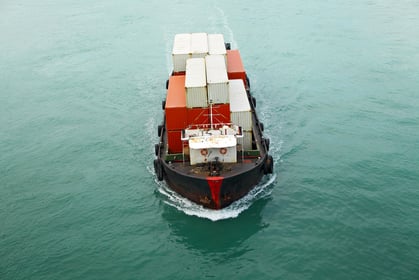What Is the Role of Automation in the Modern Supply Chain?
Martin Pahulje - April 06, 2021

The modern supply chain is all about speed. Supply chain managers are looking to jump on the latest trends to get a leg-up in the race for elite optimization. With such an array of technology and software available, all of which claim to be the key to resilience and efficiency, how does one determine the best route? If you are asking yourself this, it's time to step back and look at the big picture. You need an all-encompassing optimization solution that will tie together the software integrated into each step of your supply chain; you need automation.
Supply chain automation is the leveraging of digital technologies to lower operational costs. That’s a broad definition, but we’ll get into more detail. The technologies that automation applies to can vary, but most commonly include artificial intelligence (AI) and machine learning (ML).These systems are vital to optimizing your supply chain, and implementing further automation will ease the workload of your team and supply chain solutions.
What Activities Can Be Automated?
Automation primarily entails identifying repetitive tasks, often those that are time-consuming or error-prone, to then automate them. Because supply chains are essentially built on process-oriented tasks, it is crucial to make these tasks as efficient as possible. Supply chains can also be rife with errors as they encompass so many varying operations, ranging from manual documentation, production, inventory, shipping, and more – all of which are logistics processes that can be automated. Nearly every aspect of your supply chain can be automated, but there are three overarching types of automation that will be most beneficial to you; back-office, transportation, and warehouse. We'll detail how automation works within these categories and how to implement it properly.
Back-Office
A significant portion of supply chain management occurs behind-the-scenes. This includes procuring documents such as delivery orders, recipes, and various bills, which must be manually sorted and document to ensure the production stage can begin. The back-office process is a time-consuming one, requiring manual tasks that set the stage for all supply chain operations. Implementing automation in this process can significantly increase the speed and efficiency of tasks, achieving end-to-end document automation. Automation will also considerably reduce the occurrence of human error in this department, eliminating the risk of misplaced or incorrectly processed documents.
Transportation
Transportation can be automated in various ways, but one of the most beneficial is through AI and multi-dimensional monitoring. These technologies will provide you with real-time tracking so that you will know exactly where vehicles are, what products are in transport, and receive notification of any potential delays. This will allow you to optimize the transportation of materials andproducts in your supply chain, reducing cost and delivery time. Some organizations have even begun to utilize autonomous vehicles such as trucks and drones, automated to optimize transport supply within your network. Vehicles such as these may not require drivers, allowing you to transport goods with more flexibility.
Warehouse
Supply chain warehouses are bustling with movement, products continually being added and removed. Automating your warehouse can significantly reduce warehouse costs, ensuring that you optimize space to maximize value. One way to automate this is through supply and demand automation. This technology will automatically register inventory as it changes so that you can know precisely how many products are in stock and adjust accordingly. With this knowledge, you can identify out-of-stock or stock-at-hand items faster, ensuring that your systems reflect your inventory accurately all the time. Another excellent automotive technology is forecasting. Forecasting can be applied to a variety of stages in the supply chain but is most beneficial when predicting demand. Using historical data and market trends, you will have accurate forecasts of customer orders so that you can prep inventory in advance and ensure you have enough supply to meet demand. Additionally, you may consider implementing automated vehicles and robots within your warehouse, which operate autonomously yet collaboratively with humans. This may alleviate team members of strenuous or time-consuming tasks so that they can focus on more critical projects.
Why Automate?
There are countless reasons to implement automation in your supply chain, but two are most prominent; saving time and money. We’ll focus on two particular lean manufacturing technologies, AI and machine learning, to explain exactly how they translate into these benefits.
Manufacturing and supply chain are the two operations with the greatest likelihood of reducing costs as a result of artificial intelligence. A supply chain must have a high level of analytics-driven forecasting and optimization capabilities to achieve reduced manufacturing costs. While knowledgeable team members can manage these systems, AI is designed to handle complex operations in minimal time; one of these systems is detailed planning. AI uses precise analytics to find the optimal path in planning. This path will consider labor and machine capacity, customer requirements, material and product needs, and more. In delegating these tasks to a high-capable AI solution, you are alleviating your team members of time-consuming and strenuous tasks while eliminating the risk of human error. Another excellent ability of AI is forecasting. In forecasting future demand, you can more effectively match demand with capacity to reduce the cost of both shortages and overages. This will revolutionize your product floor in reducing machine idle time and preventing breakdowns so that you can keep up with orders.
Much like AI, machine learning (ML) is excellent leverage for the modern supply chain. Machine learning algorithms work by gathering incredible volumes of data and identify patterns invisible to the naked eye. Using this, ML can create more accurate demand forecasts than a human planner, powering improved S&OP and demand-capacity planning. This will allow you to reduce safety stock, potentially saving you significant costs. To feed ML algorithms such significant amounts of data, it is best to integrate all systems in your supply chain. This will allow technologies to feed data to one another, allowing them all to reach optimal performance. On the other end of the machine, you need to consider how you will store this data. Cloud technology has tremendous data storage capabilities, allowing you to protect and store data in an accessible decentralized location.
With the integration of end-to-end supply chain automation, you will optimize every stage in your supply chain. With more accurate forecasts and data planning, these functions will better equip your organization to handle significant volumes of data and customer orders at no extra strain on your team members. With the combination of AI and ML, with other computing systems such as the cloud, your supply chain have more visibility and resiliency than ever before. While implementing so much automation at once, it may seem as though you're reinventing your supply chain. Perhaps you are, but it's best to think about it as a technological reboot. With the help of expert supply chain solutions providers, you can start with an audit to help you determine where automation best fits in your current supply chain operations. They will lead you to the best decisions for your needs and prepare your organization for innovation. Once these systems are implemented, the hardest part is over - the automation will take care of the rest.
If you want to learn more get your Guide "Why the cloud is the future of manufacturing"
In this Guide you will learn:
-
New potential of cloud-based manufacturing
-
Opportunities of the cloud for the production
-
Technological advantage of flexis technologies
LATEST POSTS
- Understand Circular Economy in The Manufacturing Industry
- How Can Industry 4.0 IT Integration Be Achieved Smoothly?
- The Significance of Order Sequencing in Discrete Manufacturing
- How to improve your Supply Chain Management: The Power of Control Towers
- Optimizing Human Resource Scheduling in Manufacturing: A Technological Approach



